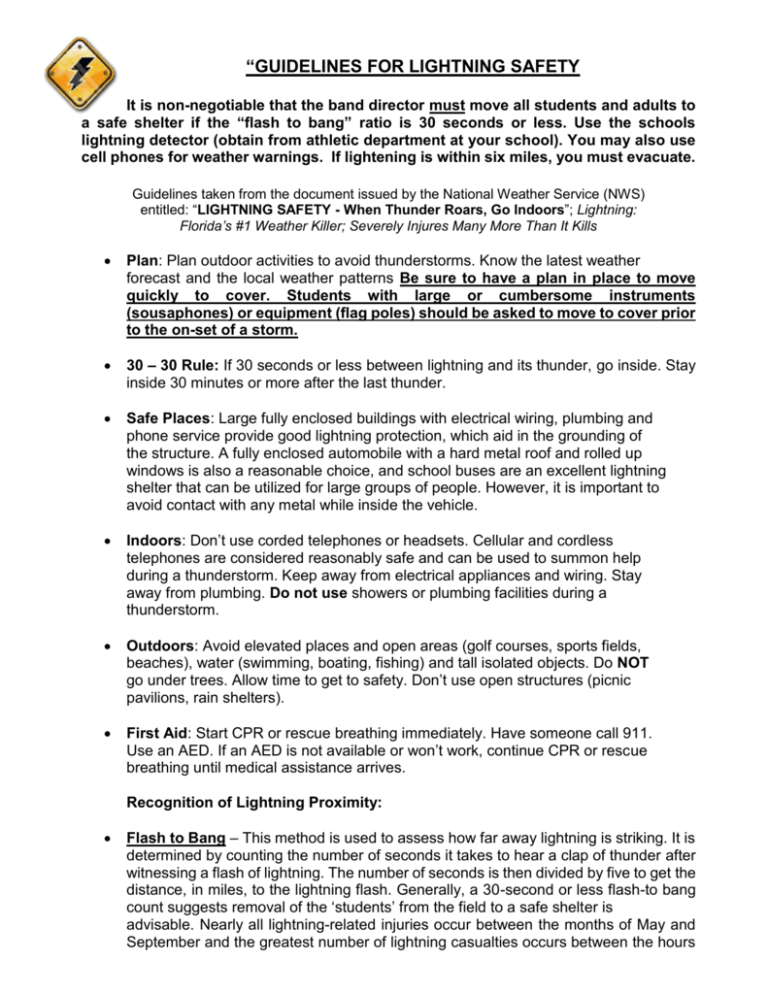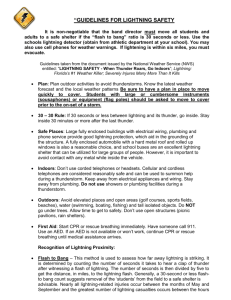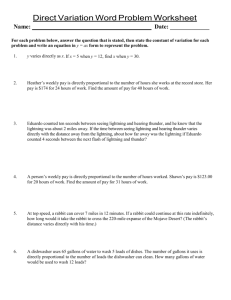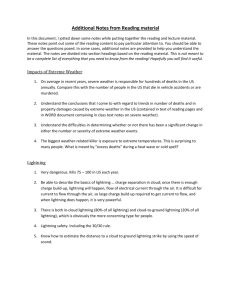guidelines for lightning safety
advertisement

“GUIDELINES FOR LIGHTNING SAFETY It is non-negotiable that the band director must move all students and adults to a safe shelter if the “flash to bang” ratio is 30 seconds or less. Use the schools lightning detector (obtain from athletic department at your school). You may also use cell phones for weather warnings. If lightening is within six miles, you must evacuate. Guidelines taken from the document issued by the National Weather Service (NWS) entitled: “LIGHTNING SAFETY - When Thunder Roars, Go Indoors”; Lightning: Florida’s #1 Weather Killer; Severely Injures Many More Than It Kills Plan: Plan outdoor activities to avoid thunderstorms. Know the latest weather forecast and the local weather patterns Be sure to have a plan in place to move quickly to cover. Students with large or cumbersome instruments (sousaphones) or equipment (flag poles) should be asked to move to cover prior to the on-set of a storm. 30 – 30 Rule: If 30 seconds or less between lightning and its thunder, go inside. Stay inside 30 minutes or more after the last thunder. Safe Places: Large fully enclosed buildings with electrical wiring, plumbing and phone service provide good lightning protection, which aid in the grounding of the structure. A fully enclosed automobile with a hard metal roof and rolled up windows is also a reasonable choice, and school buses are an excellent lightning shelter that can be utilized for large groups of people. However, it is important to avoid contact with any metal while inside the vehicle. Indoors: Don’t use corded telephones or headsets. Cellular and cordless telephones are considered reasonably safe and can be used to summon help during a thunderstorm. Keep away from electrical appliances and wiring. Stay away from plumbing. Do not use showers or plumbing facilities during a thunderstorm. Outdoors: Avoid elevated places and open areas (golf courses, sports fields, beaches), water (swimming, boating, fishing) and tall isolated objects. Do NOT go under trees. Allow time to get to safety. Don’t use open structures (picnic pavilions, rain shelters). First Aid: Start CPR or rescue breathing immediately. Have someone call 911. Use an AED. If an AED is not available or won’t work, continue CPR or rescue breathing until medical assistance arrives. Recognition of Lightning Proximity: Flash to Bang – This method is used to assess how far away lightning is striking. It is determined by counting the number of seconds it takes to hear a clap of thunder after witnessing a flash of lightning. The number of seconds is then divided by five to get the distance, in miles, to the lightning flash. Generally, a 30-second or less flash-to bang count suggests removal of the ‘students’ from the field to a safe shelter is advisable. Nearly all lightning-related injuries occur between the months of May and September and the greatest number of lightning casualties occurs between the hours of 10:00 a.m. and 7:00 p.m., with the greatest risk concentrated between 2:00 p.m. and 6:00 p.m. Evacuation Plan – All personnel should be clearly informed of available safe structures or shelters in the event a thunderstorm approaches. The person in authority must be aware of the amount of time it takes to get to each structure and the number of persons each structure can safely hold. When caught in a thunderstorm without availability or time to reach safe structures, you can minimize the risk of lightning-related injury by following a few basic guidelines: 1. Avoid being the highest object. Seek a thick grove of small trees or bushes surrounded by taller trees or a dry ditch. 2. Avoid contact with anything that would be attractive to lightning. Stay away from freestanding trees, poles, antennas, towers, bleachers, dugouts, metal fences, standing pools of water and golf carts. 3. Crouch down with legs together, the weight on the balls of the feet, arms wrapped around knees, and head down with ears covered. The existence of blue sky and the absence of rain are not protection from lightning. Lightning can and does strike as far as 10 miles away from the rain shaft. It does not have to be raining for lightning to strike. If no safe structure or location is within a reasonable distance, find a thick grove of small trees surrounded by taller trees or a dry ditch. Assume a crouched position on the ground with only the balls of the feet touching the ground, wrap your arms around your knees and lower your head. Minimize contact with the ground, because lightning current often enters the victim through the ground rather than by a direct overhead strike. Minimize your body’s surface area, and minimize contact with the ground! Do not lie flat. If unable to reach safe shelter, stay away from the tallest trees or objects (such as light poles or flag poles), metal objects (such as fences or bleachers), individual trees, standing pools of water, and open fields. Avoid being the highest object in a field. Do not take shelter under a single, tall tree. A person who feels his or her hair stand on end, or skin tingle, should immediately crouch as described above. Avoid using the telephone, except in emergency situations. People have been struck by lightning while using a land-line telephone. A cellular phone or a portable phone is a safe alternative to land-line phones, if the person and antenna are located within a safe structure or location and if all other precautions are followed. People who have been struck by lightning do not carry an electrical charge. Therefore, cardiopulmonary resuscitation (CPR) is safe for the responder. If possible, an injured person should be moved to a safer location before starting CPR. Lightning-strike victims who show signs of cardiac or respiratory arrest need emergency help quickly. Prompt, aggressive CPR has been effective for the survival of victims of lightning strikes. Resources: www.lightningsafety.noaa.gov • NCAA – National Collegiate Athletic Association • www.nfhs.org “PREVENTING HEAT ILLNESSES” The prevention of heat illness as a result of practice & performance by marching bands must be integral to the planning and design of each marching band event. It is an expectation of the health and safety of the students will be the #1 priority of band teachers in all situations. Although policies and recommendations will be presented in this section, common sense must be used in all decisions. Heat illness is defined as a medical condition that arises when the body is unable to cool itself adequately. High School band/color guard students in Florida are especially susceptible to heat illnesses due to the high temperatures and humidity levels during outdoor events. Recommended prevention policies should include, but are not limited to, the following practices. Students should: Acclimate themselves to the heat by slowly and progressively training outdoors before marching season starts. Establish a regular workout regimen throughout the summer months that includes stretching, walking and exercise. When Summer Band Camp begins, students should acclimate to the heat by working outside for the first 3-4 days in progressively longer periods to build strength, endurance and heat tolerance; for example, on the first day, march for 1 hour outside, with the remaining time spent inside (Band Room, Chorus Room, Cafeteria, Gymnasium, Covered Hallways, etc.) – on the second day, 2 hours outside, remaining time inside, etc., until students reach a standard regimen (typically 3–4 hours per day). Students should wear light colored, light-weight, loose fitting clothing and appropriate footwear (tennis shoes, athletic socks). Students should bring an additional change of clothes (or shirt) since the morning sweat may not bring an enjoyable afternoon. Appropriate hydration begins the day before a marching practice or performance. Students should begin drinking water the day before and avoid sodas and ‘sugar drinks’, as they dehydrate the body. The following is a recommended schedule for hydration the day of: 1) Drink a minimum 20 ounces of water or sports drink 2-3 hours before practice. 2) Drink 20 ounces more of water or sports drink 30 minutes before practice. 3) Check the color of your urine, generally speaking, the lighter it is, the more hydrated you are. 4) Students are to be provided water breaks every 15-20 minutes, with students afforded ample time to drink and return to practice.(approximately 5 minutes in length). At no time should hydration breaks be taken away as a disciplinary procedure. In order to properly hydrate students in a short amount of time, students may bring their own water jugs, or parent volunteers may man a ‘hydration station’ to provide this service in a timely manner. 5) Following halftime/show performances, all students should be provided with water or Gatorade-type sports drink so that no student goes without. The same is true at the conclusion of a marching practice – everyone should hydrate. 6) A good rule to follow is this: “remember: if you’re thirsty, you’re already dehydrated!” Follow appropriate diet guidelines as follows: 1) Always eat breakfast/lunch/dinner before marching practice or performance. Students should be taught that they may not skip meals, even when dieting. 2) Healthy pre-practice/performance meals should consist of items such as fresh fruit, whole grains, toast and peanut butter. Items to avoid include dairy, syrup, and high-sugar cereals. Here are some common practices that should be adopted by all bands: 1) Students should be encouraged, if not required, to wear sunscreen, sun hat and sunglasses. 2) A ‘Cooling-Off Area’ should be provided for students during breaks or when feeling ill. 3) Parent volunteers should be available to assist with students who are ill or showing signs of heat illness. Students must be taught that it is not only acceptable, but required, to notify a Band Director, adult staff member or parent volunteer in the event they are experiencing signs of heat illness. (see below) 4) Students should engage in a set of stretching exercises prior to the start of each practice. 5) Band Directors should establish an emergency procedure policy before the start of the marching season, with procedures clearly communicated to students, parents and staff. This includes 911 emergency procedures, communication to school administrators, athletic trainers and trained individuals who could give directions to emergency vehicles and direct them to the practice field. Here are common examples of heat illness: 1) Heat Rash: skin irritation from excessive sweating. 2) Muscle Cramps: painful muscle spasms during exercise. 3) Heat Exhaustion: excessive sweating, pale skin, nausea, lightheaded, dizziness, headache, or rapid weak pulse (serious medical condition). 4) Heat Stroke: Body temp over 104 degrees. Hot, red, dry skin. Absence of sweating, dizziness and confusion. Strong, rapid pulse, acting as if intoxicated (Life Threatening).








